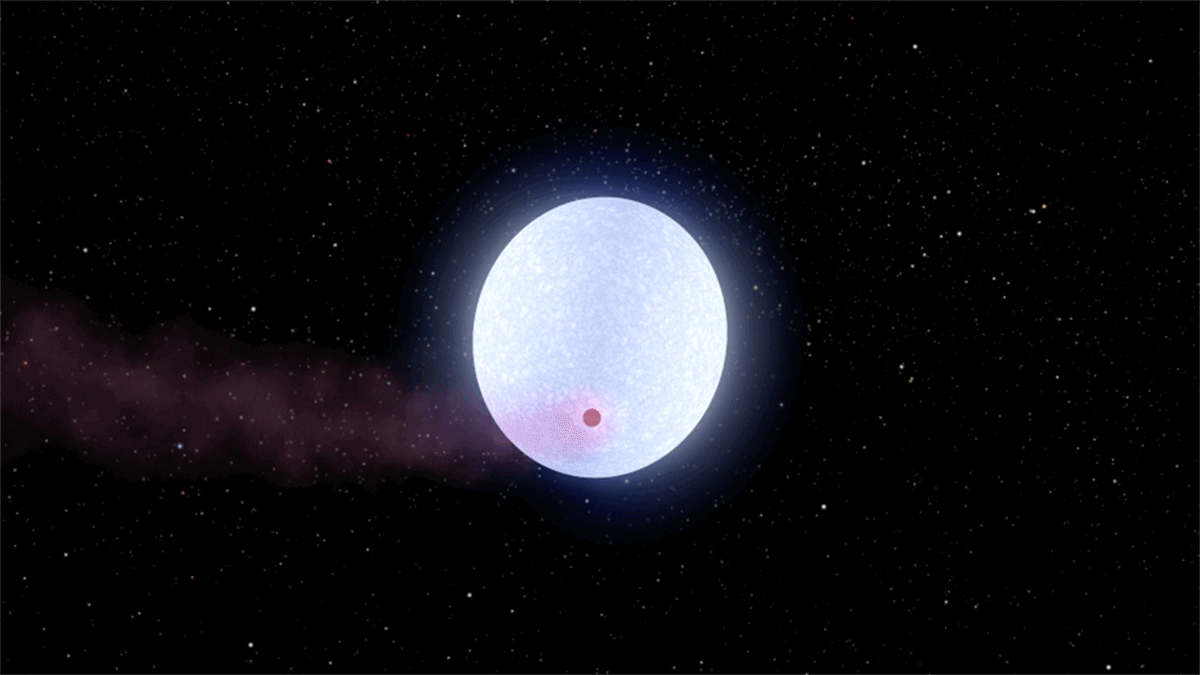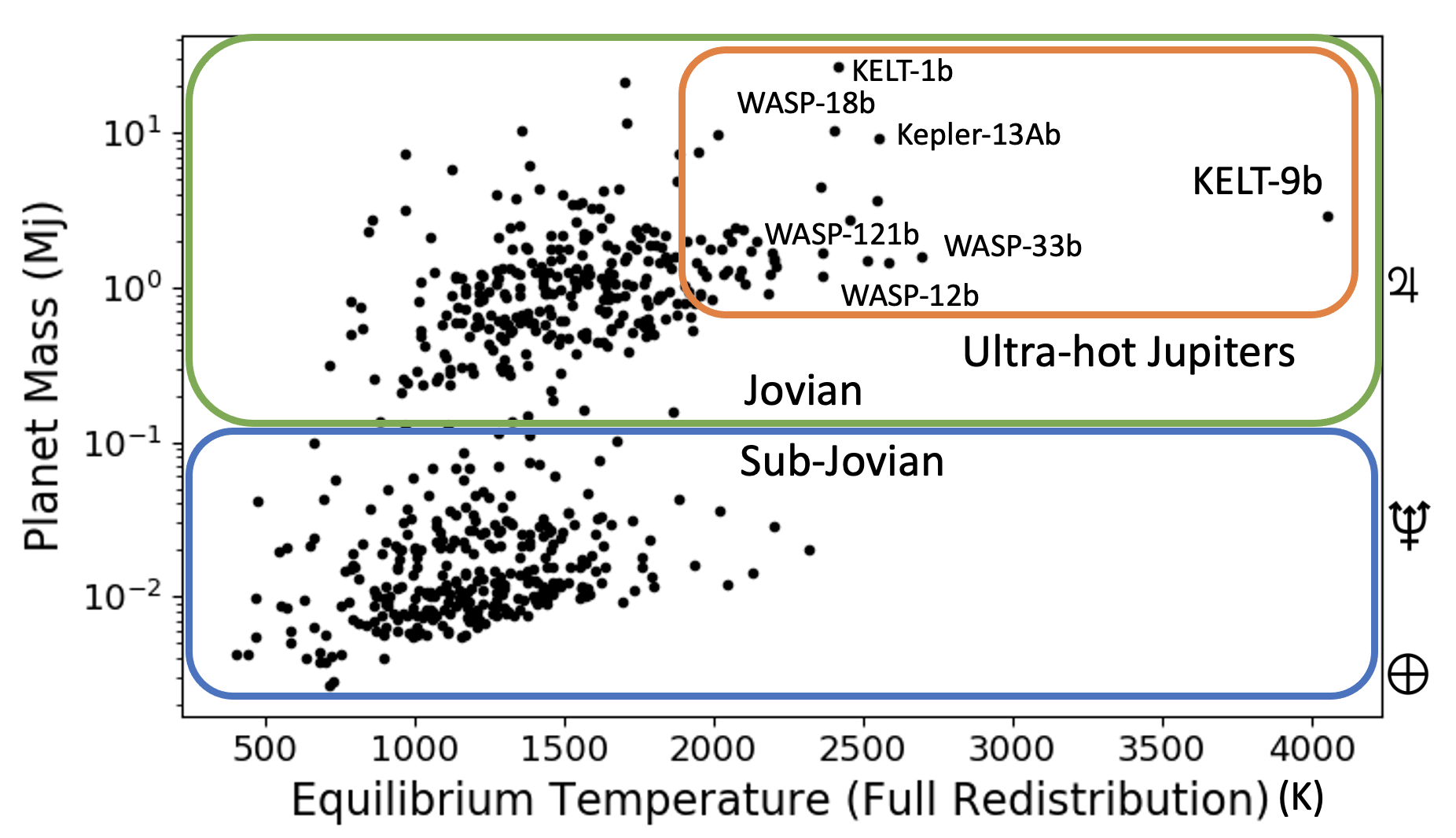KELT-9b on:
[Wikipedia]
[Google]
[Amazon]
KELT-9b is an
Exoplanet Exploration Program 2017
 KELT-9b is a relatively large
KELT-9b is a relatively large
/ref> The outer boundary of its atmosphere nearly reaches its , KELT-9b is the hottest known exoplanet, with dayside temperatures approaching 4,600 K — warmer than many low-mass stars. Molecules on the day side are broken into their component atoms, so that normally sequestered refractory elements can exist as atomic species, including neutral
, KELT-9b is the hottest known exoplanet, with dayside temperatures approaching 4,600 K — warmer than many low-mass stars. Molecules on the day side are broken into their component atoms, so that normally sequestered refractory elements can exist as atomic species, including neutral
exoplanet
An exoplanet or extrasolar planet is a planet outside the Solar System. The first possible evidence of an exoplanet was noted in 1917 but was not recognized as such. The first confirmation of detection occurred in 1992. A different planet, init ...
—more specifically, an ultra-hot Jupiter
Hot Jupiters (sometimes called hot Saturns) are a class of gas giant exoplanets that are inferred to be physically similar to Jupiter but that have very short orbital periods (). The close proximity to their stars and high surface-atmosphere t ...
—that orbits the late B-type/early A-type star KELT-9, located about 670 light-year
A light-year, alternatively spelled light year, is a large unit of length used to express astronomical distances and is equivalent to about 9.46 trillion kilometers (), or 5.88 trillion miles ().One trillion here is taken to be 101 ...
s from Earth
Earth is the third planet from the Sun and the only astronomical object known to harbor life. While large volumes of water can be found throughout the Solar System, only Earth sustains liquid surface water. About 71% of Earth's surf ...
. Detected using the Kilodegree Extremely Little Telescope
The Kilodegree Extremely Little Telescope (or KELT) is an astronomical observation system formed by two robotic telescopes that are conducting a survey for transiting exoplanets around bright stars. The project is jointly administered by memb ...
, the discovery of KELT-9b was announced in 2016. , it is the hottest known exoplanet.
Host star
The star is 2-3 times bigger and 2–5 times more massive than the sun. The surface temperature of the hoststar
A star is an astronomical object comprising a luminous spheroid of plasma held together by its gravity. The nearest star to Earth is the Sun. Many other stars are visible to the naked eye at night, but their immense distances from Earth make ...
, KELT-9, is 10,170 K, unusually hot for a star with a transit
Transit may refer to:
Arts and entertainment Film
* ''Transit'' (1979 film), a 1979 Israeli film
* ''Transit'' (2005 film), a film produced by MTV and Staying-Alive about four people in countries in the world
* ''Transit'' (2006 film), a 2006 ...
ing planet. Prior to the discovery of KELT-9b, only six A-type stars were known to have planets, of which the warmest, WASP-33, is significantly cooler at 7,430 K; no B-type stars were previously known to host planets. KELT-9, classified as B9.5-A0 could be the first B-type star known to have a planet. KELT-9b occupies a circular but strongly inclined
Incline, inclined, inclining, or inclination may refer to:
*Grade (slope), the tilt, steepness, or angle from horizontal of a topographic feature (hillside, meadow, etc.) or constructed element (road, railway, field, etc.)
*Slope, the tilt, steepn ...
orbit a mere 0.03462 AU from KELT-9 with an orbital period
The orbital period (also revolution period) is the amount of time a given astronomical object takes to complete one orbit around another object. In astronomy, it usually applies to planets or asteroids orbiting the Sun, moons orbiting planets ...
of less than 1.5 day
A day is the time period of a full rotation of the Earth with respect to the Sun. On average, this is 24 hours, 1440 minutes, or 86,400 seconds. In everyday life, the word "day" often refers to a solar day, which is the length between two so ...
s.KELT-9 bExoplanet Exploration Program 2017
Physical properties
 KELT-9b is a relatively large
KELT-9b is a relatively large giant planet
The giant planets constitute a diverse type of planet much larger than Earth. They are usually primarily composed of low-boiling-point materials ( volatiles), rather than rock or other solid matter, but massive solid planets can also exist. T ...
at about 2.8 times the mass of Jupiter
Jupiter is the fifth planet from the Sun and the largest in the Solar System. It is a gas giant with a mass more than two and a half times that of all the other planets in the Solar System combined, but slightly less than one-thousandt ...
; however, given that its radius is nearly twice that of Jupiter, its density is less than half that of Jupiter. Like many hot Jupiter
Hot Jupiters (sometimes called hot Saturns) are a class of gas giant exoplanets that are inferred to be physically similar to Jupiter but that have very short orbital periods (). The close proximity to their stars and high surface-atmosphere temp ...
s, KELT-9b is tidally locked with its host star.NASA JPL, Pasadena CA (5 June 2017) Astronomers Find Planet Hotter Than Most Stars/ref> The outer boundary of its atmosphere nearly reaches its
Roche lobe
In astronomy, the Roche lobe is the region around a star in a binary system within which orbiting material is gravitationally bound to that star. It is an approximately teardrop-shaped region bounded by a critical gravitational equipotential, ...
, implying that the planet is experiencing rapid atmospheric escape driven by the extreme amount of radiation it receives from its host star. In 2020, atmospheric loss rate was measured to be equal to 18 - 68 Earth masses per billion years.
The planet elemental abundances remains largely unconstrained as in 2022, but low carbon-to-oxygen ratio is strongly suspected.
 , KELT-9b is the hottest known exoplanet, with dayside temperatures approaching 4,600 K — warmer than many low-mass stars. Molecules on the day side are broken into their component atoms, so that normally sequestered refractory elements can exist as atomic species, including neutral
, KELT-9b is the hottest known exoplanet, with dayside temperatures approaching 4,600 K — warmer than many low-mass stars. Molecules on the day side are broken into their component atoms, so that normally sequestered refractory elements can exist as atomic species, including neutral oxygen
Oxygen is the chemical element with the symbol O and atomic number 8. It is a member of the chalcogen group in the periodic table, a highly reactive nonmetal, and an oxidizing agent that readily forms oxides with most elements as we ...
, neutral and singly ionized atomic iron
Iron () is a chemical element with symbol Fe (from la, ferrum) and atomic number 26. It is a metal that belongs to the first transition series and group 8 of the periodic table. It is, by mass, the most common element on Earth, right in ...
(Fe and Fe+) and singly ionized titanium
Titanium is a chemical element with the Symbol (chemistry), symbol Ti and atomic number 22. Found in nature only as an oxide, it can be reduced to produce a lustrous transition metal with a silver color, low density, and high strength, resista ...
(Ti+), only to temporarily reform once they reach the cooler night side, which is indirectly confirmed by measured enhanced heat transfer efficiency of 0.3 between dayside and nightside, likely diven by the latent heat of dissociation and recombination of the molecular hydrogen. Surprisingly, spectra taken in 2021 have unambiguously indicated a presence of metal oxides and hydrides in the planetary atmosphere, although higher resolution spectra taken in 2021 have not found any molecular emissions from the planetary dayside.
The thermosphere
The thermosphere is the layer in the Earth's atmosphere directly above the mesosphere and below the exosphere. Within this layer of the atmosphere, ultraviolet radiation causes photoionization/photodissociation of molecules, creating ions; the th ...
layer of KELT-9b is expected to heat up to 10,000-11,000 K, driven by ionization of heavy metals atoms like iron.
See also
*Gliese 3470 b
Gliese 3470 b, abbreviated as GJ 3470b, is an exoplanet orbiting the star Gliese 3470, located in the constellation Cancer. With a mass of just under 14 Earth-masses and a radius approximately 4.3 times that of Earth's, it is likely something aki ...
References
External links
* SIMBAD entry for HD 195689 {{Stars of Cygnus Cygnus (constellation) Transiting exoplanets Exoplanets discovered in 2016 Exoplanets discovered by KELT Hot Jupiters